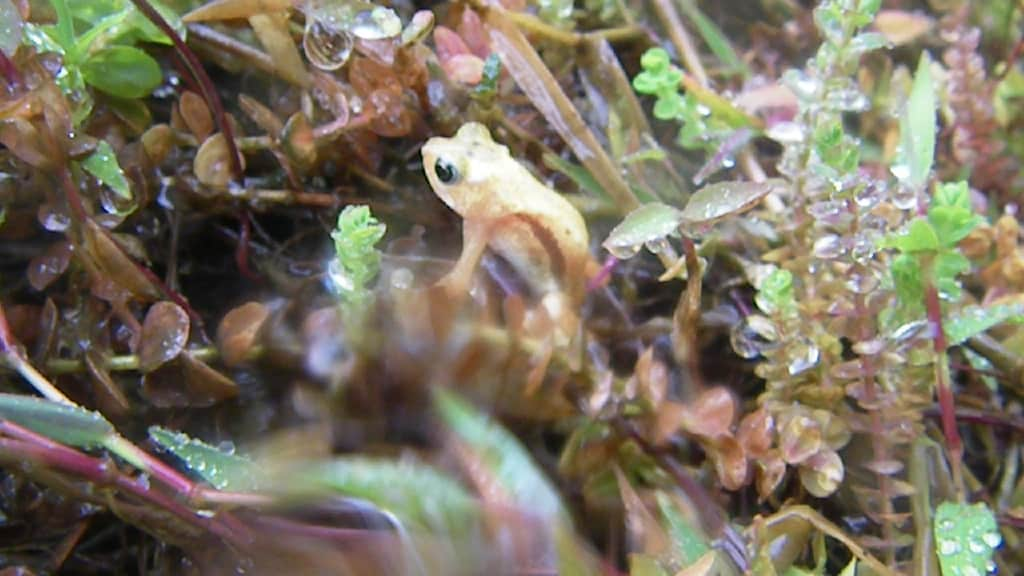Extinct Toad Restored to the Wild after 12-year Effort
OutdoorHub 12.11.12

Kihansi spray toad is first amphibian species reintroduced into its native habitat after going extinct in the wild
The Wildlife Conservation Society’s Bronx Zoo, the Toledo Zoo, Tanzanian government, World Bank and other partners have reintroduced 2,000 Kihansi spray toads into the Kihansi Gorge in Tanzania. This is the first example of an amphibian species that had been declared extinct in the wild being reintroduced into its native habitat.
The repatriation effort marks a major milestone for a species declared extinct in the wild in 2009. It is the result of a 12-year partnership to breed the toads in captivity while its habitat was restored.
Representatives from each of the partnering organizations joined WCS for the release in the Kihansi Gorge at the end of October: the Toledo Zoo, World Bank, University of Dar Es Salaam, International Union for Conservation of Nature (IUCN), Tanzania Wildlife Research Institute, Sokoine University of Agriculture, Tanzania Electric Supply Company, and local Tanzanian villagers all took part.
“The WCS Bronx Zoo has been working with our partners for more than a decade to save the Kihansi spray toad with the ultimate goal of reintroducing it back into the wild,” said Jim Breheny, Executive Vice President and General Director of WCS Zoos & Aquarium and Director of the Bronx Zoo. “The curators in the Bronx Zoo and in the Toledo Zoo – whose expertise allowed them to develop a successful husbandry and propagation program for these unique little toads – have helped to ensure the reintroduction of an important living component back into the Tanzanian ecosystem.”
The Kihansi spray toad was first discovered in 1996, living in a five-acre micro-habitat created by the spray of nearby waterfalls in the Kihansi Gorge. In 1999, the construction of a hydroelectric dam was predicted to dramatically change the Kihansi spray toad’s habitat. The micro-habitat where the toad lived was dependent on the mist created by the waterfalls in the gorge. The dam, generating nearly one-fourth of Tanzania’s electrical supply, reduced the flow of the Kihansi falls by 90 percent, drastically lessening the mist zone.
The toad was last seen in the wild in 2005, and in 2009, it was declared extinct in the wild by the IUCN. Although the ultimate cause for extinction is still debated, it is likely a combination of habitat change and the emergence of chytrid fungus, a virulent pathogen which is responsible for alarming population crashes and extinctions of amphibian species across the world.
 As the spray toad population rapidly declined, an agreement between WCS and the Tanzanian government was reached. Bronx Zoo scientists and Tanzanian officials collected an assurance colony of 499 Kihansi spray toads from the gorge. The small colony was brought back to the U.S. to initiate the off-site conservation program. Special microhabitats meeting all the environmental parameters necessary for the toads to survive were replicated in bio-secure facilities at the Bronx Zoo and later the Toledo Zoo. Both zoos were successful in breeding the toads and increasing their numbers so reintroduction efforts could commence.
As the spray toad population rapidly declined, an agreement between WCS and the Tanzanian government was reached. Bronx Zoo scientists and Tanzanian officials collected an assurance colony of 499 Kihansi spray toads from the gorge. The small colony was brought back to the U.S. to initiate the off-site conservation program. Special microhabitats meeting all the environmental parameters necessary for the toads to survive were replicated in bio-secure facilities at the Bronx Zoo and later the Toledo Zoo. Both zoos were successful in breeding the toads and increasing their numbers so reintroduction efforts could commence.
Said Dr. Cristián Samper, WCS President and CEO: “The reintroduction of the Kihansi spray toad to the Kihansi Gorge is a momentous achievement in conservation. It clearly shows how zoos can play an important role in conservation. This has been a truly global effort to save a species. This project proves that through partnership and science – wildlife can prevail.”
While the Toledo Zoo and Bronx Zoo have managed the assurance populations of Kihansi spray toads, the Tanzanian government has managed the Lower Kihansi Environment Management Project (LKEMP) in the gorge. A gravity-fed misting system was installed after construction of the dam to artificially replicate the waterfall’s spray that maintained the toad’s verdant, moist five-acre microhabitat in the gorge.
In 2010, 100 Kihansi spray toads were returned to Tanzania, where a propagation center at the University of Dar es Salaam allowed for the establishment of a third assurance population and preparations for the species’ eventual repatriation.
The Bronx Zoo sent Don Boyer, Curator of Herpetology, and Alyssa Borek, Herpetology Keeper, to participate in the reintroduction of the toads in the gorge.
“A group of about 40 people representing all partnering organizations and local villages traveled to the gorge for the ceremonial release,” said Boyer. “The enthusiasm and excitement was clear as everyone took their turn releasing a group of the toads. It was amazing to see the project reach this milestone.”
httpv://youtu.be/V-f9bwqIDzE
The Bronx and the Toledo zoos will continue to maintain an assurance population of the spray toads and have them on exhibit for visitors to see. The released toads and habitat will be closely monitored to ensure that environmental conditions remain favorable and to evaluate the progress of the animals. Additional releases may occur periodically to bolster the number of toads with the hope of having a viable, self-sustaining population.

